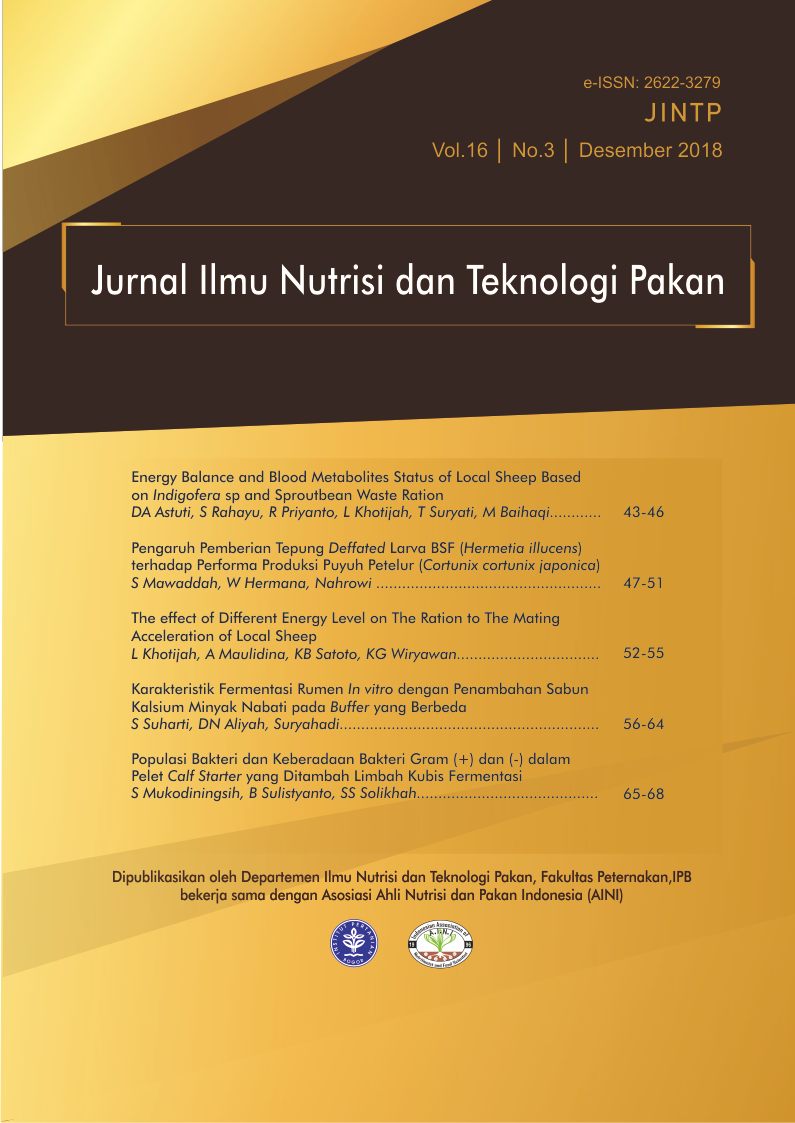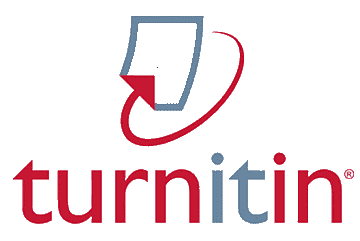Pengaruh Pemberian Tepung Deffated Larva BSF (Hermetia illucens) terhadap Performa Produksi Puyuh Petelur (Coturnix coturnix japonica)
Abstract
High quality protein feedstuff prices for poultry are more expensive due to rising prices of imported raw materials, such as fish meal and meat bone meal (MBM). Utilization of an alternative source of protein that is abundant and does not compete with food needs, becomes one of the promising solutions to optimize production efficiency. This research will evaluate the potential utilization of black soldier fly (BSF) deffated larva mal as alternative source of MBM protein in quail feed on quail production performance by using method of decreasing fat (defatting) with emphasis (pressing). Female quail 5 weeks old as many as 285 birds. Quails devided in 3 treatments and 5 replications of each 19 tails. The experimental design used in this study was a complete randomized design (CRD). The feed applied was as follows: (P1) control feed, (P2) Feed with content 50% BSF (P3) feed with 100% BSF. The results of the study 50% and 100% subtitution of BSF deffated larva meal not significantly affected on egg production evidenced by no disruption of the production of eggs and raised 5.82% (P2) and 6.13% (P3) to feed control so that it can be concluded that deffated BSF meal alternative can be used as a substitute for MBM quail in feed.
Keyword: Black soldier fly, deffated, quail, meat bone meal
Downloads
References
Čičková H, Newton GL, Lacy RC & Kozánek M. 2015. The use of fly larvae for organic waste treatment. Waste Management. 35: 68-80
Harlystiarini. 2017. Pemanfaatan tepung larva black soldier fly (hermetia illucens) sebagai sumber protein pengganti tepung ikan pada pakan puyuh petelur (Cortunix cortunix japonica) [Tesis]. Bogor (ID): Institut Pertanian Bogor
Leeson S, Summers JD. 2005. Commercial Poultry Nutrition. 3rd edition. Canada (CAN): Nottingham University Pr
Li Q, Zheng L, Qiu N, Cai H, Tomberlin JK & Yu Z. 2011. Bioconversion of dairy manure by Black Soldier Fly (Diptera: Stratiomyidae) for biodiesel and sugar production. Waste Management. 31(6):1316-1320
Mousavi SN, Khalaji S, Ghasemi-Jirdehi A & Foroudi F. 2013. Investigation on the effects of dietary protein reduction with constant ratio of digestible sulfur amino acids and threonine to lysine on performance, egg quality and protein
retention in two strains of laying hens. Italian J Animal Sci. 12 (2): 9-15
Nys Y & Guyot N. 2011. Egg Formation and Chemistry. Nys Y, Bain M, Immerseel FV, editor. Cambridge (UK): Woodhead Pub. Ltd
Oyegoke OO, Akintola AJ & Fasoranti JO. 2006. Dietary potentials of the edible larvae of Cirina forda (westwood) as a poultry feed. African J Biotechnol. 5(19):1799-1802
Premalatha M, Abbasi T, Abbasi T & Abbasi SA. 2011. Energy-efficient food production to reduce global warming and ecodegradation: The use of edible insects. Renew Sustain Energy Rev. 15(9):4357-4360
Schiavone A, Cullere M, Marco MD, Meneguz M, Biasato I, Bergagna S, Daniela D, Francesco Gi, Sihem D, Laura G & Antonella DZ. 2017. Partial or total replacement of soybean oil by black soldier fly larvae (Hermetia illucens L.) fat in broiler diets: effect on growth performances, feedchoice, blood traits, carcass characteristics and meat quality. Italian Journal of Animal Science. 16 (1) : 93–100
Steel RGD, Torrie JH. 1993. Prinsip dan Prosedur Statistika (Pendekatan Biometrik). Jakarta (ID): Gramedia Pustaka Utama. Terjemahan: B. Sumantri
Van Huis A. 2013. Potential of insects as food and feed in assuring food security. Annu Rev Entomol. 58:563-583
Veldkamp TG, Van Duinkerken A, Van Huis A, Lakemond CMM, Ottevanger E, Bosch G & Van Boekel. 2012. Insects as a suistanable feed ingredient in pig and poultry diets-a feasibility study. Wageningen (Netherlands): Wageningen UR Livestock Research
Wang D, Zhai SW, Zhang, CX, Bai YY, An SH & Xu YN. 2005. Evaluation on nutritional value of field crickets as a poultry feedstuff. Asian-Australas J Anim Sci. 18(5):667-670
The authors of the submitted manuscript have to understand and agree that the copyrights published are held by Jurnal Ilmu Nutrisi dan Teknologi Pakan. Copyrights includes rights in reproducing, distributing and selling every section of articles in all forms and media. The copyright transfer form is signed by the corresponding author. The author”
• Creative Commons Attribution (CC BY)
you are allowed to:
Share – copy and redistribute the material in any medium or format
Adapt – remix, transform, and build upon the material
for any purpose, even commercially.
The licensor cannot revoke these freedoms as long as you follow the license terms.
Jurnal Ilmu Nutrisi dan Teknologi Pakan (Nutrition and Feed Technology Journal)

This work is licensed under a Creative Commons Attribution 4.0 International License.












